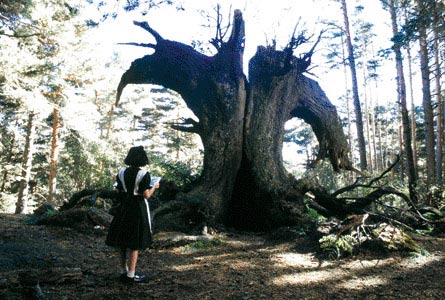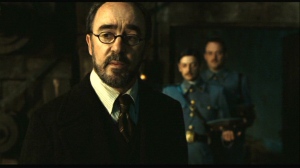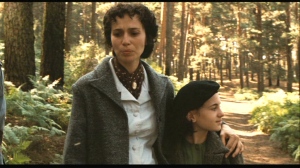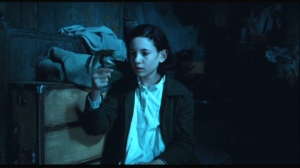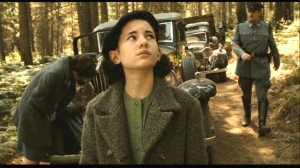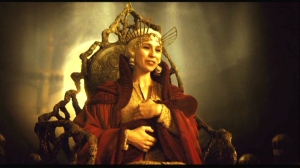Pan’s Labyrinth
Guillermo Del Toro’s Pan’s Labyrinth is a visually striking film with immaculate cinematography, every frame of this movie is absolutely beautiful, so naturally the costume design is something to admire and warrants a careful looking over. While most of the costuming in the film is rooted in realness and accuracy in terms of time and setting, the seamless way in which it works along with production design and cinematography is definitely masterful. There are definitely stand out moments when the costumes are utilized to express significant subtext along with the standard character information we, as an audience are accustomed to. Costume designer Lala Huete skillfully incorporates layers of information and references to her designs as well as providing the characters with realistic and appropriate garbs.
The use of warm and cold light is something that is played with throughout the film. I believe Del Toro has stated that in the beginning of the film the cold light is used to signify the ‘real’ world, or Ofelia’s reality and that the warm tones and lighting are used when in the fantastic realm. As the film progresses the two begin to intertwine and meld together, until the real and the fantastic become one. The screenshots above showcase this use of light, Ofelia creates a door with the chalk the Faun gives her and peers into a fantastic world lit warmly with golden tones and light. The second shot shows her entering the fantasy world and leaving behind an hourglass in the cold ‘real world’.
The use of cool and warm colors is not limited to the lighting and cinematography. The uniforms of the Spanish military is a cold, grey-blue, icy color. Oftentimes it is contrasted with the clothing of characters that stand in opposition to them.
Captain Vidal, the film’s main antagonist is visually contrasted with Mercedes. She dresses in her dark neutrals, mostly browns and beiges which clashes with Vidal’s cool blues. The grey-blue color of the uniform corresponds to Vidal’s cold and frigid personality, he is stern and unfeeling in his interactions with other people, even to Ofelia’s mother, Carmen whom he has recently married. The doctor is shown as an opposing force, from the very beginning, before Vidal learns about his work with the rebels. The doctor wears dark suits that clash with Vidal’s uniform. The clothing the rebels wear is mostly brown and tans, which not only helps them camouflage to their surroundings (their clothing matches the color of the many tree trunks in the forest) but also marks a direct contrast to the soldiers that search for them.
Ofelia’s mother is an incredibly passive character, she is sickly from the very beginning and is confined to her wheelchair and bed for the entire film. Her clothing consists generally of pale colored smocks that evoke both her physical weakness and her meek character. Unlike Ofelia, she allows Vidal to control every aspect of her stay in the country, and ultimately suffers for her inactions.
Ofelia’s clothing is comprised generally of simple frocks and dresses, usually green and neutral colors, giving her a kind of natural vibe. Her color palette consists mostly of these greens and browns and definitely suggests a tie with nature and the natural world, which is apropos of her royal identity. We see her a couple of times in her white nightgown, as she often sneaks out at night to speak to the faun, etc. The white of the nightgown, of course, supports and enforces her character as innocent and good.
“When I used to read fairy tales, I fancied that kind of thing never happened, and now here I am in the middle of one,” exclaims Alice as she roams through Wonderland and examines how she got there. In the film, Ofelia could have  easily uttered the same words. Del Toro, like many others before him, has utilized Lewis Carroll’s seminal work Alice’s Adventures in Wonderland as an important influence and template for the narrative in this film. In the article Alice’s Little Sister: Exploring Pan’s Labyrinth Kim Edwards elaborates on Alice’s influence on the film, which is, “particularly conscious of its sororal relationship with Alice and its re-imagining of a W(under)land, and with the way events below the surface of the world and the text inform reality and meaning.” Del Toro takes specific thematic and narrative cues from Carroll’s work, Edwards elaborates how, “Alice’s journey was, quite literally groundbreaking in positing a child heroine in a subterranean fantasy world, where the surreal clashed with our overt real-world satire and nonsense was imbued with disturbing meaning.” Del Toro takes this quality of Alice and applies it to post civil war Spain; he utilizes the presence of fantasy as a way to comment on the state of the country in that era. The film transplants Ofelia into a space where she is faced with the harsh realities of such a difficult time. Soon enough she falls into a fantasy world, which serves as an escape from her current reality. Ofelia, like Alice, has fallen into one of the fairytales she so eagerly consumed.
easily uttered the same words. Del Toro, like many others before him, has utilized Lewis Carroll’s seminal work Alice’s Adventures in Wonderland as an important influence and template for the narrative in this film. In the article Alice’s Little Sister: Exploring Pan’s Labyrinth Kim Edwards elaborates on Alice’s influence on the film, which is, “particularly conscious of its sororal relationship with Alice and its re-imagining of a W(under)land, and with the way events below the surface of the world and the text inform reality and meaning.” Del Toro takes specific thematic and narrative cues from Carroll’s work, Edwards elaborates how, “Alice’s journey was, quite literally groundbreaking in positing a child heroine in a subterranean fantasy world, where the surreal clashed with our overt real-world satire and nonsense was imbued with disturbing meaning.” Del Toro takes this quality of Alice and applies it to post civil war Spain; he utilizes the presence of fantasy as a way to comment on the state of the country in that era. The film transplants Ofelia into a space where she is faced with the harsh realities of such a difficult time. Soon enough she falls into a fantasy world, which serves as an escape from her current reality. Ofelia, like Alice, has fallen into one of the fairytales she so eagerly consumed.
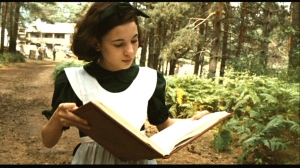 There are definitely parallels between both narratives, and Del Toro makes direct references and allusions to Carroll’s work. These allusions present themselves in different ways throughout the film, certain themes from Carroll’s story are explored in the film, and Del Toro also employs various visual references that evoke the story. He mentions in the commentary for the film that, “The movie is completely peppered with references to other fantasy movies and other fantasy works like novels and short stories. Hans Christian Anderson’s The Little Match Girl, The Wizard of Oz, Alice in Wonderland, Oscar Wilde and so on and so forth.” The most explicit and direct reference to Carroll in the film is Ofelia’s ‘Alice in Wonderland’ dress. Ofelia’s mother makes her a new dress for an important dinner, which is
There are definitely parallels between both narratives, and Del Toro makes direct references and allusions to Carroll’s work. These allusions present themselves in different ways throughout the film, certain themes from Carroll’s story are explored in the film, and Del Toro also employs various visual references that evoke the story. He mentions in the commentary for the film that, “The movie is completely peppered with references to other fantasy movies and other fantasy works like novels and short stories. Hans Christian Anderson’s The Little Match Girl, The Wizard of Oz, Alice in Wonderland, Oscar Wilde and so on and so forth.” The most explicit and direct reference to Carroll in the film is Ofelia’s ‘Alice in Wonderland’ dress. Ofelia’s mother makes her a new dress for an important dinner, which is  incredibly reminiscent of the signature ‘Alice’ dress. The dress is almost an exact copy of the now iconic dress, with the exception of its deep emerald
incredibly reminiscent of the signature ‘Alice’ dress. The dress is almost an exact copy of the now iconic dress, with the exception of its deep emerald  green color; Alice’s dress has been generally depicted as light blue through history. Her mother mentions how she will look like a princess with it on, but Ofelia seems pensive recalling how the faun told her she is Princess Moanna in their previous meetings. She is already a princess in her mind and in her fantasy world and doesn’t need a dress to validate that.
green color; Alice’s dress has been generally depicted as light blue through history. Her mother mentions how she will look like a princess with it on, but Ofelia seems pensive recalling how the faun told her she is Princess Moanna in their previous meetings. She is already a princess in her mind and in her fantasy world and doesn’t need a dress to validate that.
We can interpret that this clothing choice highlights the beginning of Ofelia’s adventure since Alice wears this throughout her journey in Wonderland. The dress might be a signifier for delving into an unknown realm, like what Wonderland is for Alice. If we see this dress as enforcing or emphasizing this sense of adventure, then it is undermined when Ofelia takes it off before heading inside the tree. This is an important moment in Ofelia’s journey; it is her first task and the first time that she is an active 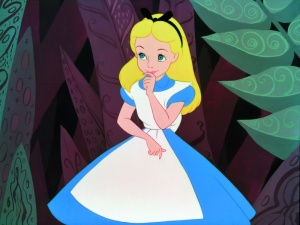 figure in the magical world. If this moment is so significant in Ofelia’s story, and her involvement in the fantasy world is heightened, then it would make sense for her to dress and appear like Alice. Of course, it makes narrative sense that she would remove it, it is a new dress and she doesn’t want to get mud in it. Del Toro explains, “…the girl’s dress, of course, echoes Alice in Wonderland and here she has to leave behind any adult concern represented by the dress… I wanted to go into the interior world without the conceit of the dress…” The dress in the film seems to symbolize, not the sense of adventure, but the powers of the real world or the adult world that control or oversee Ofelia. She is just a child, she has been relocated by her caretakers, she is surrounded by adults, most of them morally corrupt, the one constant figure in her
figure in the magical world. If this moment is so significant in Ofelia’s story, and her involvement in the fantasy world is heightened, then it would make sense for her to dress and appear like Alice. Of course, it makes narrative sense that she would remove it, it is a new dress and she doesn’t want to get mud in it. Del Toro explains, “…the girl’s dress, of course, echoes Alice in Wonderland and here she has to leave behind any adult concern represented by the dress… I wanted to go into the interior world without the conceit of the dress…” The dress in the film seems to symbolize, not the sense of adventure, but the powers of the real world or the adult world that control or oversee Ofelia. She is just a child, she has been relocated by her caretakers, she is surrounded by adults, most of them morally corrupt, the one constant figure in her  life is silenced and then eventually killed, this is the one moment when she sheds that control and attempts to take control herself. Ofelia’s act of taking the dress off separates her identity from the ‘Alice’ mold she was forged into. Ofelia is an Alice that doesn’t follow rules, that disobeys.
life is silenced and then eventually killed, this is the one moment when she sheds that control and attempts to take control herself. Ofelia’s act of taking the dress off separates her identity from the ‘Alice’ mold she was forged into. Ofelia is an Alice that doesn’t follow rules, that disobeys.
The film’s ending alludes to The Wizard of Oz, another story of a young girl uprooted from her home and forced to make her way back. Ofelia has passed the faun’s ultimate test and is rewarded with a homecoming. Her red shoes are a direct reference to Dorothy and her ruby slippers, Del Toro makes it a priority to highlight them and emphasize the connection between the characters.
Again we see the use of war tones and lights, the room is bathed in a beautiful warm glow giving the impression of comfort and sanctuary. Ofelia’s and her parents wear red and gold colored clothing and this is the first time we see these colors being worn by anybody in the film. The color red has been scattered through the film, but mostly in violent and brutal situations. This is the first time we not only see someone wearing red, but also see it being used with a more positive connotation. The color can be used to infer and symbolize different things, the love shared by the reunited family; Ofelia’s martyrdom and the fact that she sacrificed herself to keep her baby brother safe; and her courage and ultimate triumph over the many obstacles she faced. The color combination really does pronounce their royalty and grandiosity and with these clothes the filmmaker cements Ofelia’s true identity visually.
